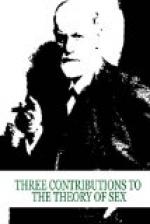[12] Although psychoanalysis has not yet given us a full explanation for the origin of inversion, it has revealed the psychic mechanism of its genesis and has essentially enriched the problems in question. In all the cases examined we have ascertained that the later inverts go through in their childhood a phase of very intense but short-lived fixation on the woman (usually on the mother) and after overcoming it they identify themselves with the woman and take themselves as the sexual object; that is, proceeding on a narcissistic basis, they look for young men resembling themselves in persons whom they wish to love as their mother has loved them. We have, moreover, frequently found that alleged inverts are by no means indifferent to the charms of women, but the excitation evoked by the woman is always transferred to a male object. They thus repeat through life the mechanism which gave origin to their inversion. Their obsessive striving for the man proves to be determined by their restless flight from the woman.
[13] The most pronounced difference between the sexual life (Liebesleben) of antiquity and ours lies in the fact that the ancients placed the emphasis on the impulse itself, while we put it on its object. The ancients extolled the impulse and were ready to ennoble through it even an inferior object, while we disparage the activity of the impulse as such and only countenance it on account of the merits of the object.
[14] I must mention here that the blind obedience evinced by the hypnotized subject to the hypnotist causes me to think that the nature of hypnosis is to be found in the unconscious fixation of the libido on the person of the hypnotizer (by means of the masochistic component of the sexual impulse).
Ferenczi connects this character of suggestibility with the “parent complex” (Jahrbuch fuer Psychoanalytische und psychopathologische Forschungen, I, 1909).
[15] Moreover, it is to be noted that sexual overvaluation does not become pronounced in all mechanisms of object selection, and that we shall later learn to know another and more direct explanation for the sexual role of the other parts of the body.




